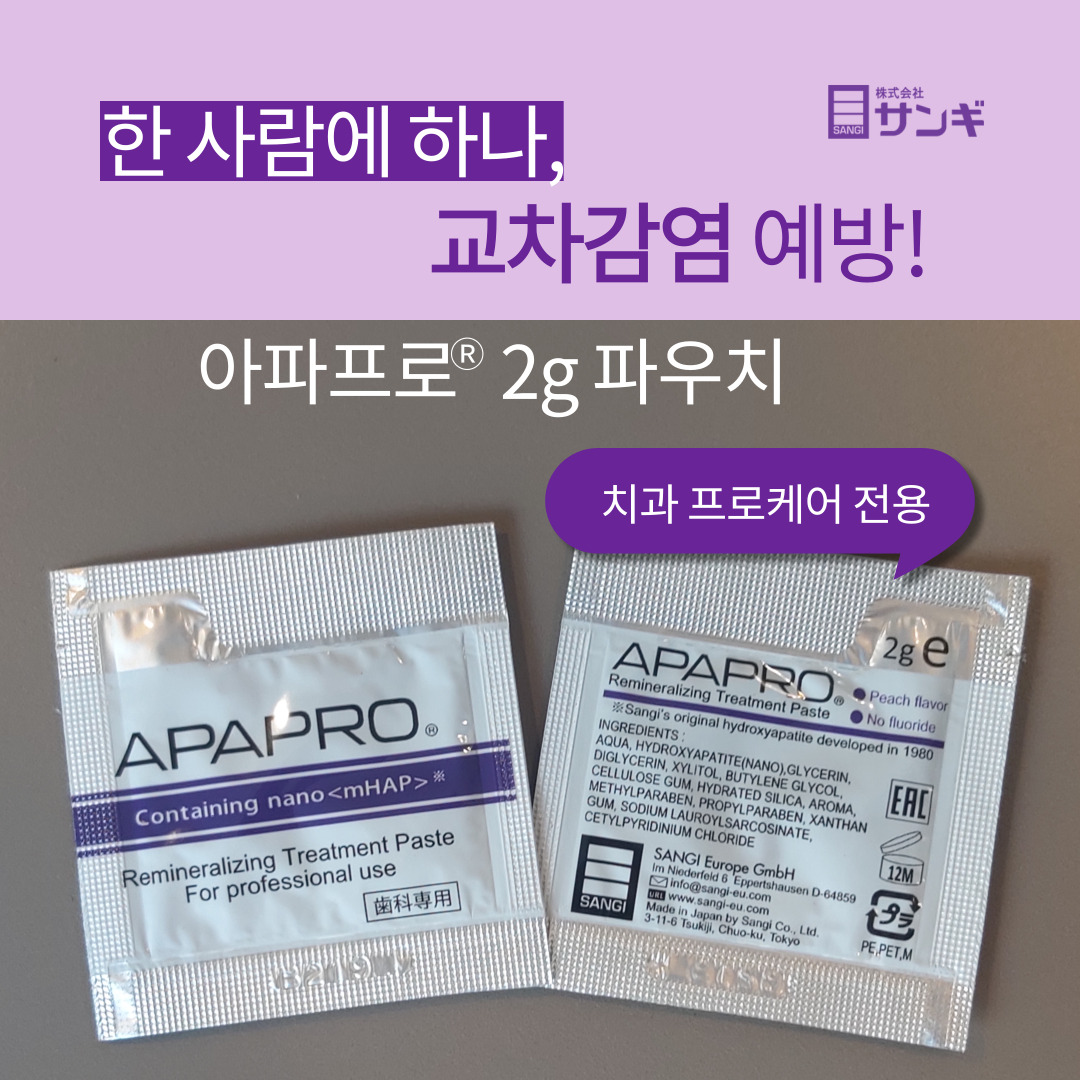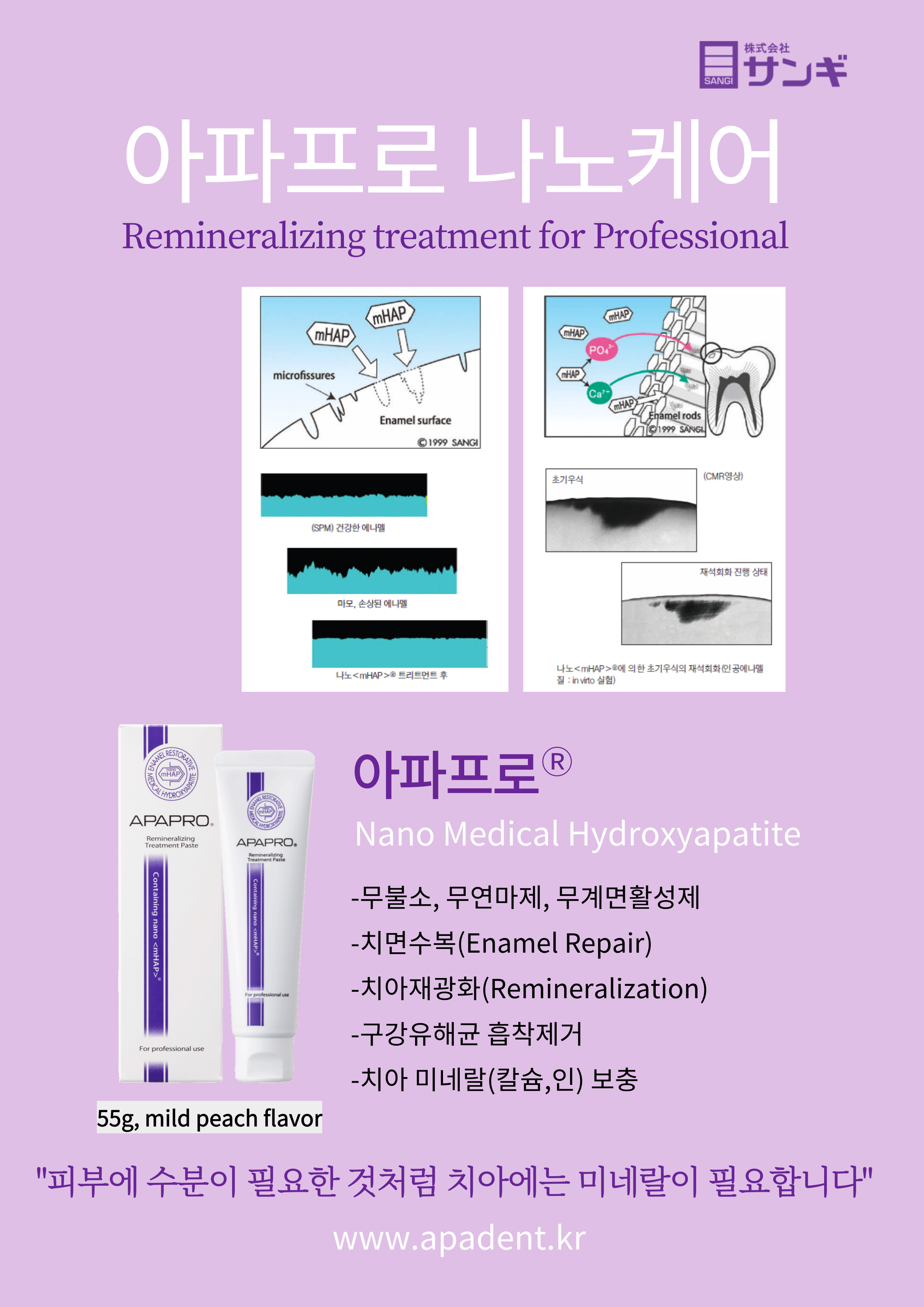| subject | 레이저와 나노 하이드록시아파타이트를 이용한 구강관리 |
|---|---|
| writer | admin |
| admin@domain.com | |
| date | 22-02-14 14:52 |
| hit | 614 |
관련링크본문레이저와 나노 하이드록시아파타이트를 함께 사용하면 충치예방과 시린이 케어에 뛰어난 효과를 발휘합니다.
ScientificWorldJournal. 2014; 2014:
798732. Published
online 2014 Oct 20. doi: 10.1155/2014/798732 PMCID: PMC4217242 PMID: 25386616 The
Effects of CO2 Laser with or without Nanohydroxyapatite Paste
in the Occlusion of Dentinal Tubules Mohammed
Abbood Al-maliky, 1 , * Ali
Shukur Mahmood, 2 Tamara
Sardar Al-karadaghi, 2 Christoph
Kurzmann, 1 Markus
Laky, 3 Alexander
Franz, 4 and Andreas
Moritz 1 , 3 전문 링크 https://www.ncbi.nlm.nih.gov/pmc/articles/PMC4217242/ The aim of this study was to
evaluate a new treatment modality for the occlusion of dentinal tubules (DTs)
via the combination of 10.6 µm carbon
dioxide (CO2) laser and nanoparticle hydroxyapatite paste (n-HAp).
Forty-six sound human molars were used in the current experiment. Ten of the
molars were used to assess the temperature elevation during lasing. Thirty were
evaluated for dentinal permeability test, subdivided into 3 groups: the control
group (C), laser only (L−), and laser plus n-HAp (L+). Six samples, two
per group, were used for surface and cross section morphology, evaluated
through scanning electron microscope (SEM). The temperature measurement results
showed that the maximum temperature increase was 3.2°C. Morphologically groups
(L−) and (L+) presented narrower DTs, and almost a
complete occlusion of the dentinal tubules for group (L+) was found. The
Kruskal-Wallis nonparametric test for permeability test data showed statistical
differences between the groups (P < 0.05).
For intergroup comparison all groups were statistically different from each
other, with group (L+) showing significant less dye penetration than the
control group. We concluded that CO2 laser
in moderate power density combined with n-HAp seems to be a good treatment
modality for reducing the permeability of dentin. J
Clin Exp Dent. 2017 Dec; 9(12): e1390–e1396. Published
online 2017 Dec 1. doi: 10.4317/jced.54044 PMCID: PMC5794115 PMID: 29410753 The effects of fractional CO2 laser, Nano-hydroxyapatite
and MI paste on mechanical properties of bovine enamel after bleaching Horieh
Moosavi1 and Narjes Hakimi2 Background This study investigated the effect of post
bleaching treatments to the change of enamel elastic modulus and microhardness
after dental bleaching in- vitro. Material
and Methods Fifty bovine incisor slab were randomly
assigned into five groups (n=10). The samples were bleached for three times; 20
minutes each time, by 40% hydrogen peroxide. Next it was applied fractional CO2
laser for two minutes, Nano- hydroxy apatite (N-HA) and MI-paste for 7 days and
2 minutes per day. The sound enamel and bleached teeth without post treatment
remained as control groups. The elastic modulus and microhardness were measured
at three times; 24 hours, 1 and 2 months. Data were statistically analyzed by
two-way analysis of variance with 95% confidence level. Results Different methods of enamel treatment caused
a significant increase in elastic modulus compared to bleached group (P<0.05).
Modulus was significantly increased in 1 and 2 months (P<0/001:
bleach, P= 0/015: laser, P= 0/008: NHA, P=0/010:
MI paste) but there were no significantly difference between 1 and 2 months (P>0.05).
There was any significance difference for hardness among treated and control
groups, but hardness increased significantly by increasing storage time (P<0.05). Conclusions The use of the protective tested agents can
be useful in clinical practice to reduce negative changes of enamel surface
after whitening procedures. Key words:Bleaching enamel, CO2 laser, MI pastes, Nano-hydroxy apatite,
Microhardness, Elastic modulus. Volume 129, September
2020, 106225 The effects on dentin tubules of two
desensitising agents in combination with Nd:YAG laser: An in vitro analysis
(CLSM and SEM) Yesim Sesen
Uslua,⁎
, Nazmiye Donmezb a Istanbul Okan University, Faculty of Dentistry, Department
of Restorative Dentistry, Istanbul, Turkey b Bezmialem Vakif University,
Faculty of Dentistry, Department of Restorative Dentistry, Istanbul, Turkey Objectives:
The aim of this study was to assess in vitro the effects of two desensitising
agents containing calcium phosphate and nano-hydroxyapatite, applied alone or
with Nd:YAG laser, on dentin tubule occlusion, and to determine the penetration
depth. Methods: 75 extracted human 3rd molar teeth were used. The effects of
desensitising treatments and erosion resistance were evaluated on dentin tubule
occlusion via SEM and the dentin tubule penetration depth via CLSM. Two
desensitising agents—Teethmate (TMD), (Kuraray, Japan) and Professional Oral
Care Nano-hydroxyapatite (Nhap) Desensitiser (Miromed Group SA, Italy)—were
used. Study groups were designated as Group 1(Control), Group 2(TMD), Group
3(TMD+Nd:YAG), Group 4(Nhap) and Group 5(Nhap+Nd:YAG) and were assigned 10
dentin discs per group. After treatment with desensitising agents and laser,
dentin discs were exposed to artificial saliva for one night in samples
prepared to be without erosion and a sample prepared as with erosion was
exposed 3 times per day for 5 days to 0.3% citric acid cycles. The Image J
programme was used to scale the images of SEM analyses. The agents were mixed
with 0.1% Rhodamine B for testing penetration depth and samples were analysed
with CLSM after applying with and without laser. The obtained images were
evaluated using the Zeiss ZEN Lite, Zeiss Microscopy programme (Carl Zeiss,
Germany). Data were analysed with MannWhitney U and Kruskal Wallis tests (p
< 0.05). Results: Statistically significant differences from the control
group were found in all treatment groups. The TMD +Nd:YAG group had the lowest
number of open tubules before and after erosion and the highest penetration
depth. The Nd: YAG laser markedly increased the efficiency of the desensitising
agents. Journal of Fundamental and Clinical
Research https://jfcr.journals.ekb.eg/ ISSN 2735-023X Vol. 1, No. 2, 53-68,
December 2021 Effect of Diode Laser Treatment and
Nano-Desensitizing Agent on Degree of Tubular Occlusion "In Vitro
Study" Salma Raafat1 , Ola Fahmy2 , Hussein Gomaa3
, Mohamed Abd El-Hamid4 , Passant EL-Asaly5 ABSTRACT Background: Dentin Hypersensitivity is a
common dental problem affecting a huge section of every population that doesn’t
have a permanent treatment yet. Aim: The purpose of this study is to compare
the effect of Diode laser (940nm) and Nano-desensitizing agent on the degree of
tubular occlusion compared to the conventional fluoride varnish for the
treatment of dentin hypersensitivity. Materials and methods: Twenty dentin
specimens were prepared from extracted human premolars. Dentin specimens will
be randomly allocated in 4 groups (n=5) according to desensitizing agent used:
D1 (Diode Laser (940nm), D2 (Nano-hydroxyapatite), D3 (Diode Laser +
Nano-hydroxyapatite) and D4 (Fluoride). The specimens will be treated with EDTA
for 2 mins to open dentinal tubules simulating Dentin Hypersensitivity. Each
specimen will be evaluated at 3 different times: T0 (before material
application), T1 (after material application) and T2 (after acid attack) using
Environmental Scanning Electron Microscope and Image Analysis software to
detect degree of occlusion of dentinal tubules. Results: Group D3 showed
statistically significant tubular occlusion percentage compared to the other
groups except group D1. After acid attack group D3 were the only group that
showed non-statistically significant decrease in tubular occlusion percentage
denoting the best resistance to acid attack, while other groups were
drastically affected by the acid attack. Conclusion: Combining DL (940nm) and
Nano-hydroxyapatite could be a successful treatment option for Dentin
Hypersensitivity, due to its high degree of tubular occlusion effect and
sustainability in the acidic environment. Keywords: Dentin Hypersensitivity,
Tooth Sensitivity, Diode Lasers
18
February 2014 Does ozone enhance the remineralizing
potential of nanohydroxyapatite on artificially demineralized enamel? A laser
induced fluorescence study Samuelraj
Srinivasan, Vijendra
Prabhu, Subhash Chandra, Shalini
Koshy, Shashidhar Acharya, Krishna
Kishore Mahato Abstract The
present era of minimal invasive dentistry emphasizes the early detection and
remineralization of initial enamel caries. Ozone has been shown to reverse the
initial demineralization before the integrity of the enamel surface is lost.
Nano-hydroxyapatite is a proven remineralizing agent for early enamel caries.
In the present study, the effect of ozone in enhancing the remineralizing
potential of nano-hydroxyapatite on artificially demineralized enamel was
investigated using laser induced fluorescence. Thirty five sound human
premolars were collected from healthy subjects undergoing orthodontic
treatment. Fluorescence was recorded by exciting the mesial surfaces using 325
nm He-Cd laser with 2 mW power. Tooth specimens were subjected to
demineralization to create initial enamel caries. Following which the specimens
were divided into three groups, i.e ozone (ozonated water for 2 min), without
ozone and artificial saliva. Remineralization regimen was followed for 3 weeks.
The fluorescence spectra of the specimens were recorded from all the three
experimental groups at baseline, after demineralization and remineralization.
The average spectrum for each experimental group was used for statistical
analysis. Fluorescence intensities of Ozone treated specimens following
remineralization were higher than that of artificial saliva, and this
difference was found to be statistically significant (P<0.0001). In a
nutshell, ozone enhanced the remineralizing potential of nanohydroxyapatite,
and laser induced fluorescence was found to be effective in assessing the
surface mineral changes in enamel. Ozone can be considered an effective agent
in reversing the initial enamel caries there by preventing the tooth from
entering into the repetitive restorative cycle.
|
|
댓글목록
등록된 댓글이 없습니다.

